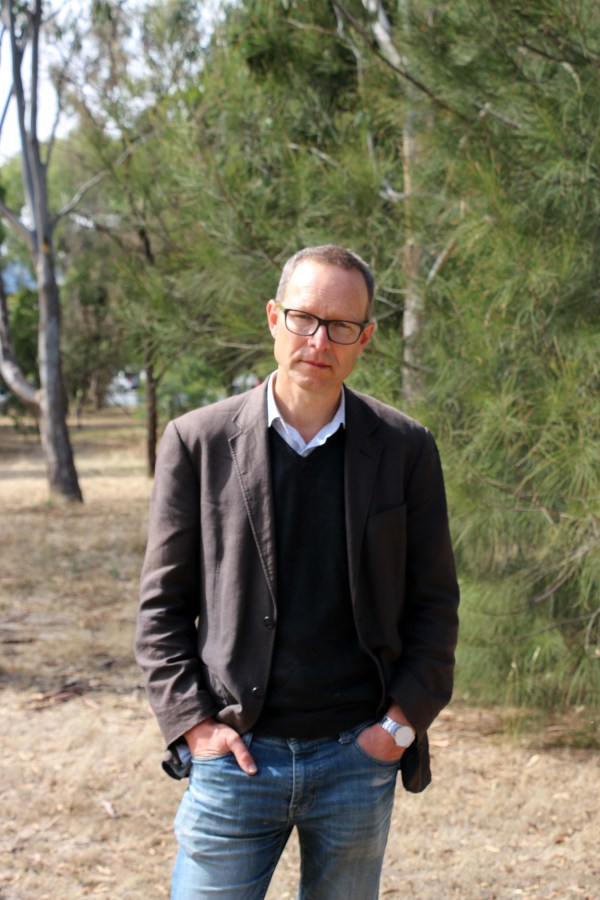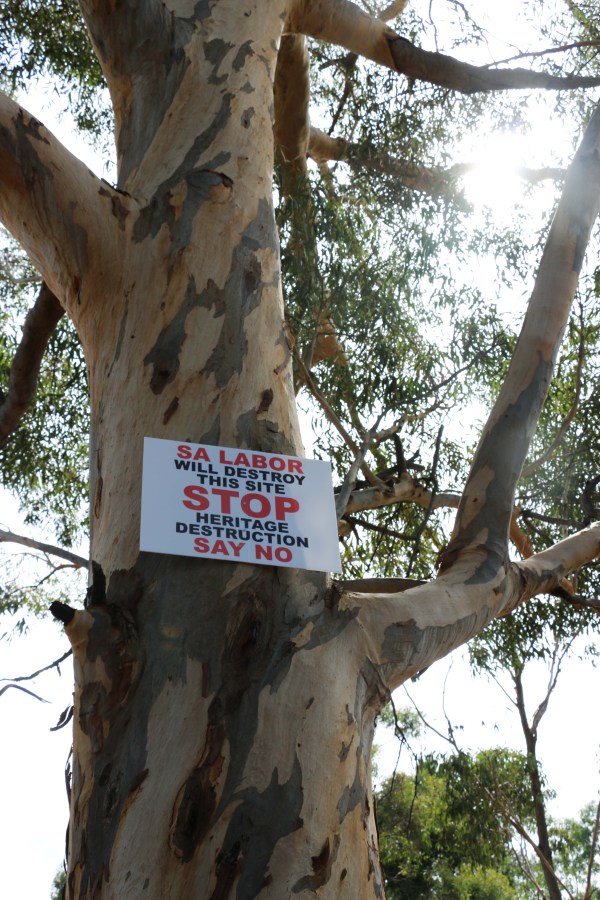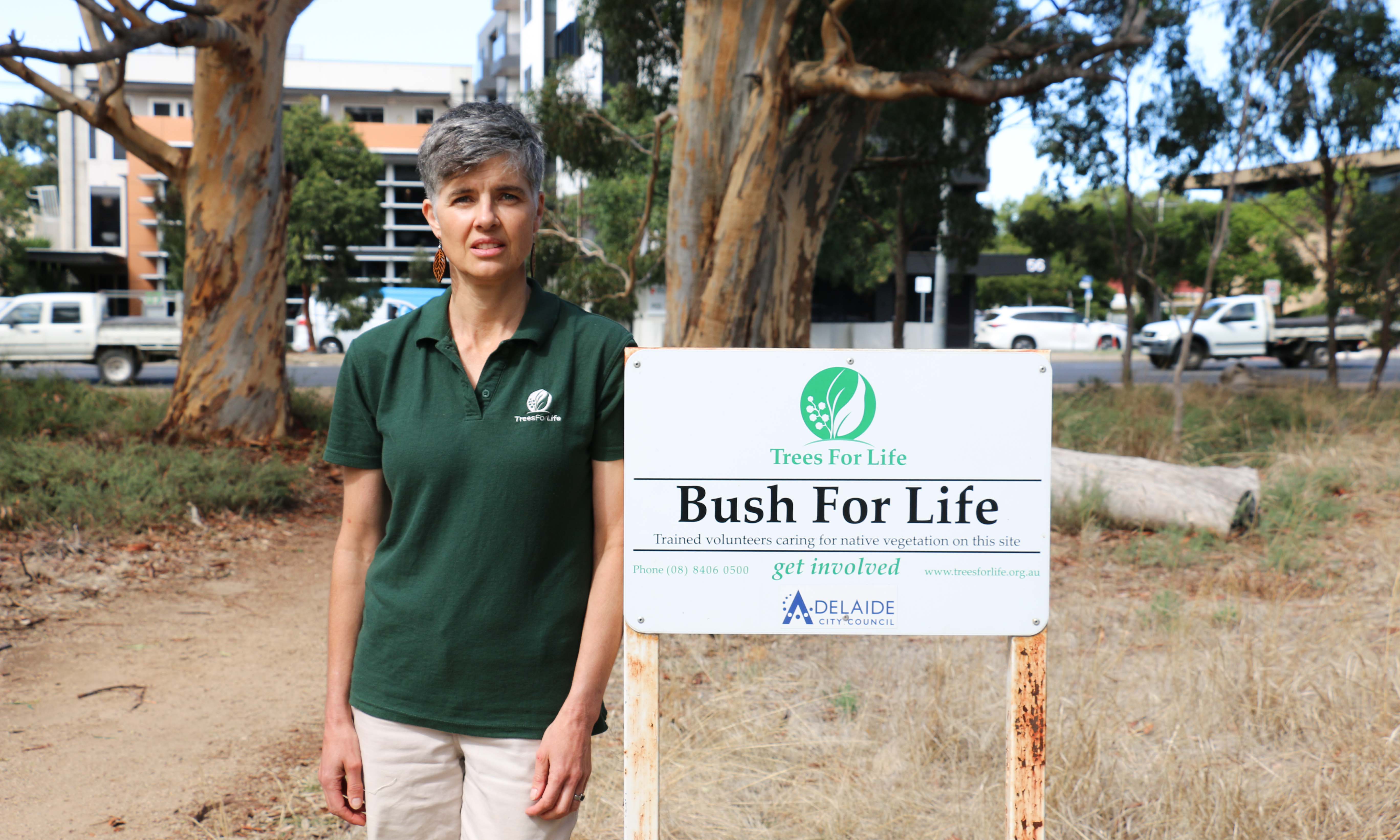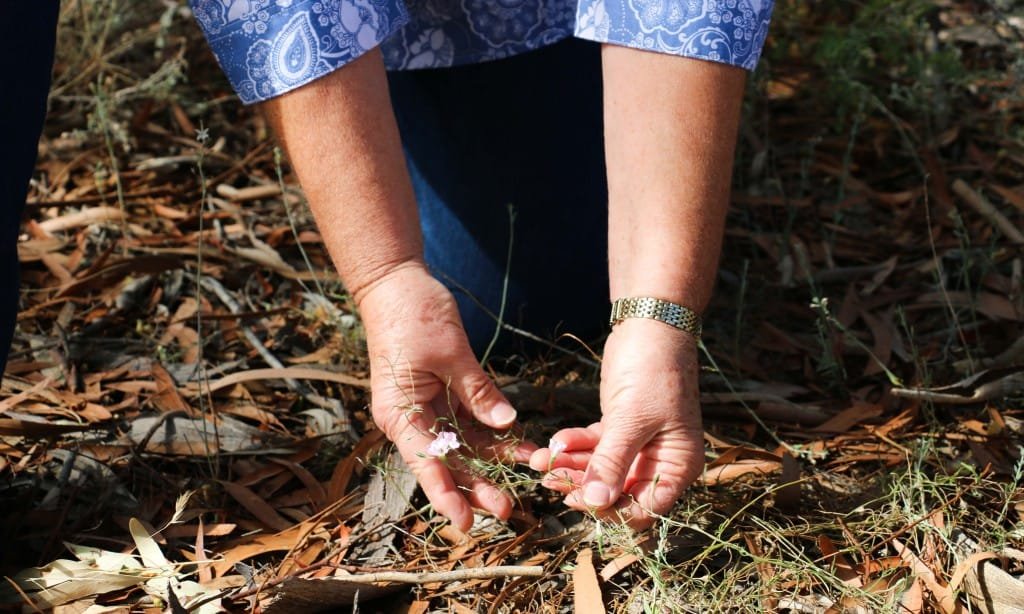[ad_1]
Ann Prescott is kneeling, holding a native purple daisy between her fingers. It’s so small you almost can’t see it.
“I’m not going to show you anything that’s not native, not today,” she tells CityMag.
With the buzz of the city’s traffic on Greenhill Road behind her, the field biologist walks over to a break between the yellow meadows — filled with wallaby, windmill and spear grasses — in Mirnu Wirra Park 21 West in the city’s far south. She points to a chocolate lily, identifying the native vegetation with ease.
Ann is a leading South Australian botanist. She has worked with the Adelaide City Council for five years surveying the Park Lands’ natural ecosystem, and has a particular interest in grasses. She did a stint working as the World Wildlife Fund’s grasslands extension officer.
Today, on a sticky Monday morning, Ann guides us through this patch of the city’s green belt that’s recently been mooted for development by the South Australian Police (SAPOL). Strips of dried gum tree bark and eucalyptus leaves crack under her feet. She points to an inconspicuous ant nest; a disk of dry dirt dotted with black bodies. Tiny meat ants carry seeds and dead bugs on their backs, bringing a feast back to the colony and their queen.
“This is the most important historic record of what the Park Lands was at the time of settlement, and it’s precious,” Anne says. “It’s like Ayers House or Ayers Rock; it’s really, really important heritage.”
At the time of our chat, Ann is flanked by an army of concerned environmentalists and conservationists unified by one cause: to oppose South Australia Police’s plan to develop Mirnu Wirra Park 21 West for the Mounted Operations Unit.


Above: The contingent fighting for Mirnu Wirra Park 21 West; Right: Ann Prescott
She is joined by the chief executive of the Conservation Council, Craig Wilkins; CEO of Trees for Life, Natasha Davis; Butterfly Conservation Society chairperson, Gerry Butler, and member, Greg Coote.
The proposed site, located in the southeastern corner of the park, would cater to 40 police horses, dogs, and include ancillary buildings to support the barracks’ operations.
Catalysing SAPOL’s move is the State Government’s new $3 billion Women’s and Children’s Hospital. To allow space for the hospital, the State Government will need to raze 10 heritage-listed Thebarton Police Barracks buildings — the current home of the Mounted Operations Unit.
Part of the bill allowing this to occur, which was rushed through parliament, includes a “miscellaneous” passage which says SAPOL can select a new patch of the Park Lands for the barracks’ new home.
“The relevant Minister must ensure that the land that vests under this section is used by SA Police for the purposes of its Mounted Operations Unit,” the document says.
On Sunday, 11 March — the middle of a long weekend — SAPOL told The Advertiser the site for its new barracks, Mirnu Wirra Park 21 West, is “disused”. A subsequent opinion piece in the paper mocked the notion that this park is a “haven of biodiversity”. “I drive down it most days and, as pretty as it is, the Amazon it ain’t,” the piece says.
Ann strongly refutes this. “It’s not vacant. It’s working its heart out as being what it used to be,” she says. And if the powers that be wipe out this park, a teeming biodiversity hub, she says “they’d be responsible for basically wiping out a part of our living book of history”.
This part of the park has more than 70 different plant species, cracked clay dirt, and feeds the area’s growing network of bugs, birds and animals. Part of what makes this park so special is the network of clay soils, which are not great for tree species but especially beneficial for native grasses.

The cracked clay forms a great foundation for native grasses to grow
There are 15 native species found in this park, which have a “significant correlation” with the local grassy habitats and grassy soils, a report penned by Ann says. An additional three rare species are found here, with a “near threatened” species, the pink flowering creeper, aka Convolvulus angustissimus, also calling this area home.
Gerry Butler, the head of the Butterfly Conservation Society, points to a purple native daisy near Ann’s shoe.
“This is one of the nectar sources for the Chequered Copper butterfly,” he says, referring to the rust-coloured butterfly which has been sighted in this area. This rare bug’s usual home is in Pakapakanthi Victoria Park, in the east Adelaide Park Lands, but has been seen as far as this area. It needs open areas with native grasses to survive.

L—R: Greg Coote and Gerry Butler
Gerry, who wears a wide-brimmed hat and butterfly-emblazoned polo shirt, says Mirnu Wirra is important as it has the adequate depth and breadth of biodiversity to support the butterflies, of which there are 20 different species in this park alone. He says the diverse vegetation allowed for different species to coexist.
“It enables the ants that support the butterfly, and the mutual symbiosis between this little ant and the caterpillar and the butterfly to actually have an environment that is right and good for them,” he says. The fact that this park is abundant in native grasses and mistletoe in gumtrees means it provides “that web of life for birds and lizards, and for other fauna to exist.”
Greg Coote, a member of the Butterfly Conservation Society, joins in the discussion, saying the park works in harmony with other pockets of wildlife around metropolitan Adelaide.
Holding a selection of large printed photographs of butterflies in varying stages of life — eggs to pupae to fully-formed critters — he says this place is a “microcosm” of the city’s larger environmental world. If you “start to unravel the whole web, you lose” it all, he says.

A photograph of a Chequered copper butterfly next to a nectar source
Wearing a blazer and jeans, Craig Wilkins, CEO of the Conservation Council, says if the State Government had conducted community and expert consultation, this site would have immediately been ruled out.
“It would have been just wiped out as an option because along this stretch of the southern park lands, there are very few parts that talk about what the Adelaide Plains were before European settlement,” he says. “This is like a living museum of biodiversity.”
From the moment the new Women’s and Children’s Hospital bill was introduced to into State Parliament late last year, Craig had a “nervous” inkling there would be no public consultation. He was right.
“The way the legislation was drafted [has] meant that it could be a decision without talking to people like Adelaide City Council or the Environment Minister, and as a result, they’ve chosen a site which may work from a police perspective, but does not work for a community or an environmental perspective,” he says.

Craig Wilkins
Adelaide Lord Mayor Jane Lomax-Smith has publicly opposed the location, penning an opinion piece, published by our sister news site InDaily yesterday, arguing the current State Government has followed an “aggressive pro-development agenda in our park lands”.
CityMag reached out to SAPOL about why they chose this location, and whether they were aware of the environmental costs of building infrastructure here. We received an email saying all questions regarding the movement of the Mounted Operations Unit should be referred to the Department of Premier and Cabinet.
A government spokesperson says SAPOL identified this site because it is the “safest” and “most suitable” for its Mounted Operations Unit. The reason the barracks have been located in the Adelaide Park Lands historically is due to the proximity to the city, easy access, “optimal environment for horses and low environmental impact”.
“Further detailed design and scoping analysis is now being undertaken by the State Government,” the spokesperson says.
“Any activity undertaken during the establishment of the new Mounted Operations Unit facility will seek to minimise the visual and physical impact in the area.
“In addition, the government will be working towards returning further green spaces to the Park Lands, like the old netball courts at Edwards Park.”

One of many political placards at Mirnu Wirra Park 21 West
Labor politician Lucy Hood, MP for Adelaide, tells CityMag the police greys are a “beloved” and important public safety asset for the community and have been located in the Park Lands since the 1900s.
“I note Council’s opposition but make the point that Adelaide City Council receives payment from both private horse owners to agist their animals on the Park Lands, as well as from private schools for club rooms on Park Lands,” she says.
Lucy adds that 30,000sqm of land will be turned into “accessible park lands, including bitumised (sic) and dilapidated areas” as a response to the new Women’s and Children’s Hospital being built.
In regards to other State Government projects occurring on the city’s green belt, the government is delivering on a new Adelaide Aquatic Centre on Park 2, and there will be “no net loss of Park Lands” with “the existing site returning to Park Lands once the new centre is built,” Lucy says.
“Expanding Botanic High was another election commitment of both major parties, and again there will be no net loss of Park Lands.”

A resident of Mirnu Wirra Park 21 West
CityMag also contacted Environment Minister Susan Close for comment, but her media advisor told us the Park Lands do not fit under her purview. We were then re-routed to Planning Minister Nick Champion, and asked for comment about whether the minister was concerned about flattening an important environmental area. We did not get a response.
Since 2015, an official group of Trees for Life volunteers have pruned and weeded the area of invasive nasties to ensure the native species stand a chance. Natasha Davis, CEO of the not-for-profit green thumb group, says she is writing letters and meeting politicians arguing for other options to be considered for the location of the barracks.
In a letter sent to South Australia Police Commissioner Grant Stevens last Friday, seen by CityMag, Natasha reiterates this park is “not an empty, dry barren patch of dirt as has been implied in the media”. Natasha says she has not received a response to this letter.
“What is important is invisible to the eye,” she tells us, pushing her bicycle as she walks, manoeuvring around a tiny cricket. The yellow-tailed black-cockatoo can be found here sometimes, in transit between other locations. “We all need a home, and plants and animals need a home too, and I think as humans we forget that. We [just] think about ourselves,” she says.
Natasha also says it’s “hypocritical” for Adelaide to refer to itself as a National Park City when “shocking policy failures” and “contradictions” prioritise infrastructure development over the environment.
“We’re a National Park City, the second in the world,” Natasha says, “but here we are right in the city centre and potentially destroying one of the most important biodiversity spots.”

Trees for Life CEO Natasha Davis
The group of environmentalists, botanists and butterfly aficionados will continue the fight by organising a rally against the proposal. They will also continue to work behind the scenes, lobby the State Government and the South Australia Police to choose another site for its operations.
As we leave the park, we see Ann kneeling over a swathe of cracked dirt, which looks like it has a lightning bolt shot through it. Dried bushes are nearby. A horn from a truck blasts through the silence.
“Every time they develop a bit, we shrink the bits that are still functioning for the birds and insects and ants and worms,” she says.
[ad_2]
Source link



